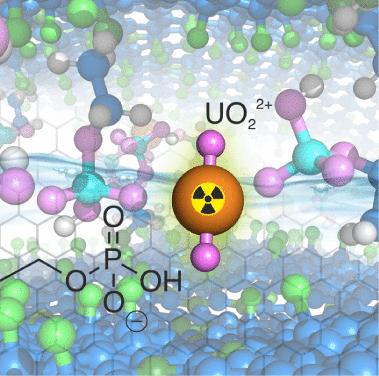用于高效铀分离和回收的磷酰石墨烯
IF 8.2
2区 材料科学
Q1 MATERIALS SCIENCE, MULTIDISCIPLINARY
引用次数: 0
摘要
为了加强核能的可持续性和保护环境,从各种水源中有效地提取铀已成为应对核废料管理长期挑战的一项基本战略。在本研究中,我们设计了磷基功能化石墨烯(PG),用于高效吸附铀酰,并在溶剂热条件下用磷基乙醇胺合成了氟化石墨烯材料。合成的PG具有独特的二维结构,配有溶剂暴露的磷酰基,使其非常适合在水溶液中吸附铀。值得注意的是,PG在pH为7的水介质中表现出较高的吸附效率(约77%),对U(VI)的快速萃取能力(约5分钟),吸附量为316 mg U g-1。循环3次后仍具有良好的可回收性和稳定性,海水吸附量为117.8 mg U - 1。x射线光电子能谱分析和分子动力学模拟显示,铀酰离子优先与PG的磷基结合。这项工作为设计和开发功能石墨烯衍生物铺平了道路,用于从各种水资源中高效提取铀,并具有回收其他放射性元素的潜力。本文章由计算机程序翻译,如有差异,请以英文原文为准。

Phosphoryl-Graphene for High-Efficiency Uranium Separation and Recycling
To enhance the sustainability of nuclear energy and protect the environment, the efficient extraction of uranium from various water sources has emerged as an essential strategy for addressing the long-term challenges of nuclear waste management. In this study, we designed phosphoryl-functionalized graphene (PG) for efficient uranyl adsorption and synthesized the material from fluorinated graphene using phosphoryl ethanolamine under solvothermal conditions. The resultant PG features a unique 2D structure equipped with solvent-exposed phosphoryl groups, making it highly suitable for uranium adsorption in aqueous solutions. Notably, PG demonstrated a high sorption efficiency (∼77%) with rapid extraction capability (∼5 min) for U(VI) from aqueous media at pH 7, achieving an adsorption capacity of 316 mg U g–1. It also demonstrates good recyclability and stability even after 3 cycles and exhibits a significant seawater adsorption capacity of 117.8 mg U g–1. Both X-ray photoelectron spectroscopy analysis and molecular dynamics simulations revealed a preferential binding of uranyl ions to the phosphoryl groups of PG. This work paves the way for designing and developing functional graphene derivatives for efficient uranium extraction from various water resources, with promising potential for the recovery of other radioactive elements.
求助全文
通过发布文献求助,成功后即可免费获取论文全文。
去求助
来源期刊

ACS Applied Materials & Interfaces
工程技术-材料科学:综合
CiteScore
16.00
自引率
6.30%
发文量
4978
审稿时长
1.8 months
期刊介绍:
ACS Applied Materials & Interfaces is a leading interdisciplinary journal that brings together chemists, engineers, physicists, and biologists to explore the development and utilization of newly-discovered materials and interfacial processes for specific applications. Our journal has experienced remarkable growth since its establishment in 2009, both in terms of the number of articles published and the impact of the research showcased. We are proud to foster a truly global community, with the majority of published articles originating from outside the United States, reflecting the rapid growth of applied research worldwide.
 求助内容:
求助内容: 应助结果提醒方式:
应助结果提醒方式:


